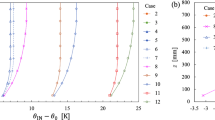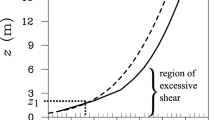Abstract
Three sets of nonlinear similarity functions for strong stability are selected to compare their performance in bulk parameterization. To uncover their advantages and disadvantages, theoretical and measurement analyses are made with four profile metrics and the Deacon number technique. Main disadvantages include the negligence of the different transfer efficiency between momentum and heat, the flux cutoff due to the upper limit in gradient Richardson number (Ri) and the ignorance of limited stability range where the dimensionless gradient functions (\({\varphi_{{\rm M}}}\) and \({\varphi_{{\rm H}}}\)) approach constants. Accordingly, three suggestions are made for future improvement. First, the functions for wind velocity and potential temperature should have the same function form, but with different coefficients. Second, \({\varphi_{\rm M}}\) and \({\varphi _{\rm H}}\) should approach constants only within a certain stability range. Third, the limit value in Ri should be avoided to widen their applicability in flux modeling. Furthermore, quantitative comparisons in transfer coefficients for moment and sensible heat (C D and C H) are made among the similarity functions in the bulk Richardson number (Ri B) range 0 < Ri B < 1. Generally, significant discrepancy is found, which may approach a factor of two and three at large Ri B in C D and C H, respectively. Finally, a new recommendation is made to one of the three sets, mainly because of its ability to predict C D and C H that decrease rather slowly in very stable conditions.
Similar content being viewed by others
Abbreviations
- C D :
-
bulk transfer coefficient for momentum
- C H :
-
bulk transfer coefficient for heat
- c p :
-
specific heat capacity of air
- d :
-
zero-plane displacement
- D H :
-
Deacon number for potential temperature profile
- D M :
-
Deacon number for wind velocity profile
- g :
-
gravity acceleration
- H :
-
sensible heat flux
- L :
-
Obukhov length
- Pr:
-
turbulent Prandtl number
- Ri :
-
gradient Richardson number
- Ri B :
-
bulk Richardson number
- T 0 :
-
reference temperature near the ground
- \({\overline u }\) :
-
mean wind velocity
- \({u_\ast }\) :
-
friction velocity
- z :
-
height above the ground
- z 0H :
-
roughness length for heat
- z 0M :
-
roughness length for momentum
- \({\varphi_{\rm M }}\) :
-
dimensionless gradient function for wind velocity
- \({\varphi_{\rm H }}\) :
-
dimensionless gradient function for potential temperature
- κ:
-
von Karman constant
- \({\overline \theta }\) :
-
mean potential temperature
- \({\overline \theta_0}\) :
-
mean potential temperature at the roughness length for heat
- \({\theta_\ast }\) :
-
temperature scale
- ρ:
-
air density
- τ:
-
turbulent momentum flux
- \({\Psi_{\rm H}}\) :
-
stability correction function for potential temperature
- \({\Psi _{\rm M }}\) :
-
stability correction function for wind velocity
- ζ:
-
dimensionless stability parameter
References
Krishnamurti TN, Bounoua A (1996) An introduction to numerical weather prediction techniques. CRC press, Florida
Kalnay E (2003) Atmospheric modeling, data assimilation and predictability. Cambridge University Press, Cambridge
McGuffie K, Henderson-Sellers A (2005) A climate modelling primer. Wiley, England
Mahrt L (1999) Stratified atmospheric boundary layer. Bound-Layer Meteorol 90:375–396
Kitaigorodskii SA, Donelan MA (1984) Wind-wave effects on gas transfer. In: Brutseart W, Jirka GH (eds) Gas transfer at the water surface. Reidel Publish Comp., Holland, pp 147–170
Chen F, Janjic Z, Mitchell K (1997) Impact of atmospheric surface-layer parameterization in the new land-surface scheme of the NCEP mesoscale Eta model. Bound-Layer Meteorol 85:391–421
Louis JF (1979) A parametric model of the vertical eddy fluxes in the atmosphere. Bound-Layer Meteorol 17:187–202
Businger JA, Wyngaard JC, Izumi Y, Bradley EF (1971) Flux-profile relationships in the atmospheric surface layer. J Atmos Sci 28:181–189
Dyer AJ (1974) A review of the flux–profile relationships. Bound-Layer Meteorol 7:363–372
Högström ULF (1996) Review of some of the characteristics of the atmospheric surface layer. Bound-Layer Meteorol 78:215–246
Webb EK (1970) Profile relationships: the log-linear range, and extension to strong stability. Q J R Meteorol Soc 96:67–90
Yaglom AM (1977) Comments on wind and temperature flux–profile relationships. Bound-Layer Meteorol 11:89–102
Blumel K (2000) An approximate analytical solution of flux–profile relationships for the atmospheric surface layer with different momentum and heat roughness lengths. Bound-Layer Meteorol 97:251–271
Yang K, Tamai N, Koike T (2001) Analytical solutions of surface similarity equations. J Appl Meteorol 40:1647–1653
Sharan M, Rama Krishna TVBPS, Aditi (2003) On the bulk Richardson number and flux-profile relations in an atmospheric surface layer under weak wind stable conditions. Atmos Environ 37:3681–3691
Poulos G, Blumen W, Fritts D, Lundquist J, Sun J, Burns S, Nappo C, Banta R, Newsom R, Cuxart J, Terradellas E, Balsley B, Jensen M (2002) CASES-99: a comprehensive investigation of the stable nocturnal boundary layer. Bull Am Meteorol Soc 83:555–581
Clarke RH (1970) Observational studies in the atmospheric boundary layer. Q J R Meteorol Soc 96:91–114
Hicks BB (1976) Wind profile relationships from the “Wangara” experiment. Q J R Meteorol Soc 102:535–551
Carson DJ, Richards PJR (1978) Modelling surface turbulent fluxes in stable conditions. Bound-Layer Meteorol 14:67–81
Holtslag AAM, DeBruin HAR (1988) Applied modeling of the nighttime surface energy balance over land. J Appl Meteorol 27:689–687
Beljaars ACM, Holtslag AAM (1991) Flux parameterization over land surfaces for atmospheric models. J Appl Meteorol 30:327–341
Cheng YG, Brutsaert W (2005) Flux–profile relationships for wind speed and temperature in the stable atmospheric boundary layer. Bound-Layer Meteorol 114:519–538
Poulos G, Burns S (2003) An evaluation of bulk Ri-based surface layer flux formulations for stable and very stable conditions with intermittent turbulence. J Atmos Sci 60:2523–2537
Pleim JE (2006) A simple, efficient solution of flux-profile relationships in the atmospheric surface layer. J Appl Meteorol Climatol 45:341–347
Launiainen J (1995) Derivation of the relationship between the Obukhov stability parameter and the bulk Richardson number for flux–profile studies. Bound-Layer Meteorol 76:165–179
Abdella K, McFarlane NA (1996) Parameterization of the surface-layer exchange coefficients for atmospheric models. Bound-Layer Meteorol 80:223–248
Lo AK (1996) On the role of roughness lengths in flux parameterization of Bound-Layer models. Bound-Layer Meteorol 80:403–413
Garratt JR (1978) Transfer characteristics for a heterogeneous surface of large aerodynamic roughness. Q J R Meteorol Soc 104:491–502
Garratt JR, Francey RJ (1978) Bulk characteristics of heat transfer in the unstable, baroclinic atmospheric boundary layer. Bound-Layer Meteorol 15:399–421
Andreas EL (2002) Parameterizing scalar transfer over snow and ice: a review. J Hydrometeorol 3:417–432
Beljaars ACM, Viterbo P (1998) Role of the boundary layer in a numerical weather prediciton model. In: Holtslag AAM, Duyukerke PG (eds) Clear and cloudy boundary layers. KNAW, Amsterdam, pp 287–304
Kondo J, Kenechika O, Yasuda N (1978) Heat and momentum transfer under strong stability in the atmospheric surface layer. J Atmos Sci 35:1012–1021
Handorf D, Foken T, Kottmeier C (1999) The stable atmospheric boundary layer over an Antarctic ice sheet. Bound-Layer Meteorol 91:165–186
Lettau HH (1979) Wind and temperature profile prediction for diabatic surface layers including strong inversion cases. Bound-Layer Meteorol 17:443–464
Viswanadham Y (1979) Relation of Richardson number to the curvature of the wind profile. Bound-Layer Meteorol 17:537–544
Viswanadham Y (1982) Examination of the empirical flux–profile models in the atmospheric surface boundary layer. Bound-Layer Meteorol 22:61–77
Moriwaki R, Kanda M (2006) Flux-gradient profiles for momentum and heat over an urban surface. Theor Appl Climatol 84:127–135
Kim J, Mahrt L (1992) Simple formulation of turbulent mixing in the stable free atmospheric and nocturnal boundary layer. Tellus 44A:381–394
Mahrt L, Vickers D (2005) Extremely weak mixing in stable conditions. Bound-Layer Meteorol 119:19–39
Lettau HH (1956) Note on the structure of the atmospheric surface layer. J Meteorol 13:507–509
Kosovic B, Curry JA (2000) A large eddy simulation study of a quasi-steady, stably stratified atmospheric boundary layer. J Atmos Sci 57:1052–1068
Cheng Y, Canuto VM, Howard AM (2002) An improved model for the turbulent PBL. J Atmos Sci 59:1550–1565
Louis JF, Tiedtke M, Geleyn JF (1981) A short history of the operational PBL parameterization at ECMWF. In: Proceedings of workshop on planetary boundary parameterization. Reading, U K, ECMWF, pp 59–79
Delage Y (1997) Parameterising sub-grid scale vertical transport in atmospheric models under statically stable conditions. Bound-Layer Meteorol 31:303–323
Klipp CL, Mahrt L (2004) Flux-gradient relationship, self-correlation and intermittency in the stable boundary layer. Q J R Meteorol Soc 130:2087–2103
Xu M, Jiang WM, Hu F, Chen HY (2002) The characteristics of turbulent moisture on Huaihe river basin in China. Meteorol Atmos Phys 81:53–65
Arya SP (1991) Finite-difference errors in estimation of gradients in the atmospheric surface layer. J Appl Meteorol 30:251–253
Author information
Authors and Affiliations
Corresponding author
Rights and permissions
About this article
Cite this article
Guo, X., Zhang, H. A performance comparison between nonlinear similarity functions in bulk parameterization for very stable conditions. Environ Fluid Mech 7, 239–257 (2007). https://doi.org/10.1007/s10652-006-9015-2
Received:
Accepted:
Published:
Issue Date:
DOI: https://doi.org/10.1007/s10652-006-9015-2




